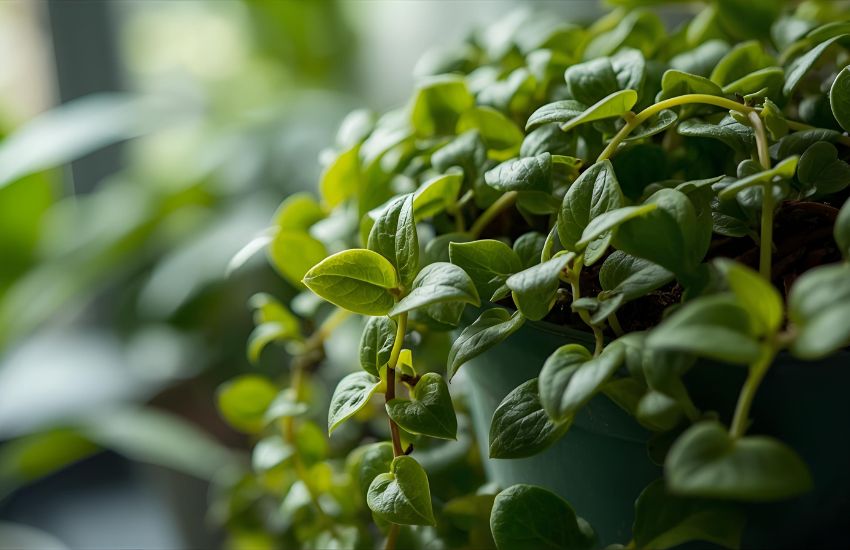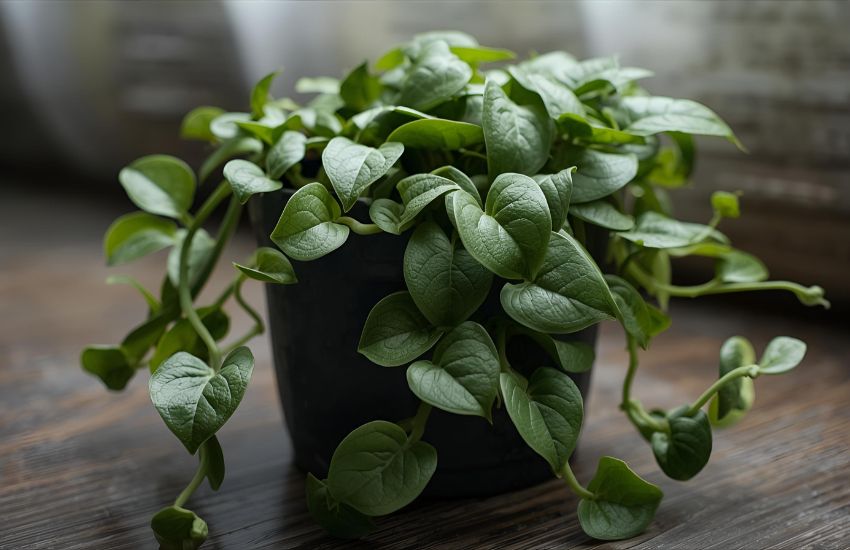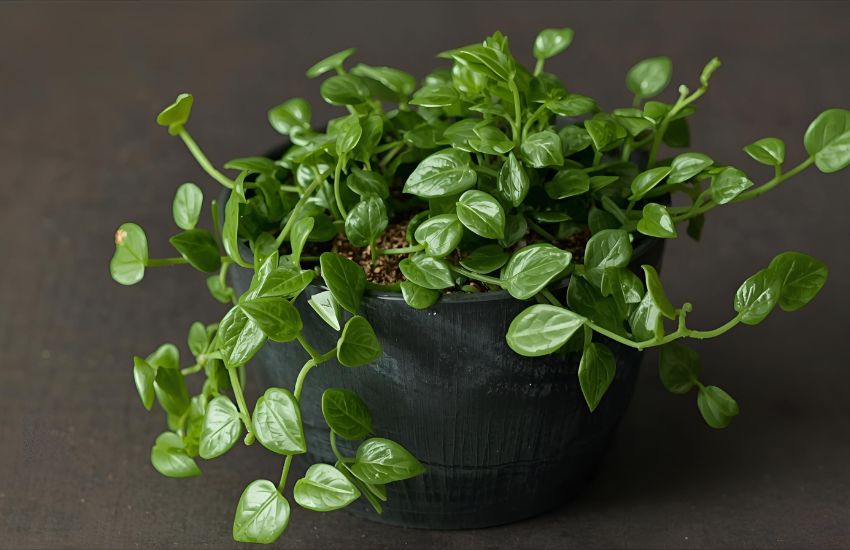The Turtle Vine, also known as Callisia repens, often captures attention with its lush trailing foliage and fast growth. As a tropical species native to America, it thrives when you give it the right balance of soil, water, and humidity. Its small, fleshy leaves display a striking green and purple color, forming a dense covering that makes it an attractive ground cover or a delightful hanging houseplant. With its creeping habit and delicate stems, this plant can quickly trail several inches, adding beauty to shady corners where many others fail to thrive.
Turtle Vine (Callisia repens) thrives in bright, indirect light with moderate to high humidity. Keep the soil evenly moist but not soggy, and use well-draining soil to prevent root rot. Mist the plant regularly or place it near a humidifier. Prune often to maintain compact growth and encourage a fuller, trailing appearance indoors.
If you’re considering how to keep its foliage healthy through the seasons, from summer to winter, you’ll benefit from learning practical care methods such as when to water, how to use a cutting to propagate new plants, and which pot placement prevents invasive spreading. This guide will provide you with every tip you need—from protecting it from too much sun to encouraging root stability—so you can confidently enjoy the beauty of Turtle Vine indoors or outdoors.
How to Propagate and Prune Turtle Vine for Healthier Growth

Propagation and pruning are two essential practices that help your Turtle Vine, also called an inch plant, maintain healthier growth and vibrant foliage. This tropical creeper responds well to simple cutting techniques, where you trim a few healthy stems and replant them to establish fresh roots.
By doing so, you not only propagate new plants but also encourage the mother plant to grow more compact and dense. Since the Turtle Vine often trails beautifully in hanging baskets or when grown indoors, regular pruning prevents it from becoming too leggy and helps highlight its striking purple tones.
When pruning, always cut just above a node to promote branching and keep the foliage fuller. If grown indoors, place it where it receives bright but indirect light, as too much sun can fade its color. With consistent care, your Turtle Vine may even surprise you with tiny white flowers, adding extra charm to its trailing stems.
Whether you grow it in an indoor container or allow it to spill over in larger arrangements, pruning and propagation remain the key steps to keeping this plant healthy, balanced, and visually appealing over time.
Common Turtle Vine Plant Pests and Diseases You Should Know

Turtle Vine (Callisia repens) is admired for its trailing charm and fast-growing nature, but like many houseplants, it can encounter certain pests and diseases if not given the right care. Understanding these common issues will help you protect your plant and ensure it continues to thrive.
Susceptibility to Pests
The most frequent pest problems you may notice on Turtle Vine are aphids, mealybugs, and spider mites. These insects feed on plant sap, leaving behind discolored leaves and weakening the plant’s growth. Regularly inspecting the foliage and stems will allow you to act early. Wiping leaves with a damp cloth or applying an insecticidal soap solution can control these intruders effectively.
Root and Fungal Issues
Overwatering is one of the most common mistakes with Turtle Vine. Poor drainage causes the roots to remain overly moist, which invites fungal infections and root rot. To prevent this, always check soil moisture before watering and avoid waterlogging. Keeping the plant in a space with balanced airflow helps reduce fungal risk.
Environmental Stress
Turtle Vine can adapt to different conditions, but extreme temperature fluctuations and unsuitable climate can stress the plant, making it more vulnerable to pests and disease. While it can handle bright areas, too much full sun may scorch its delicate leaves. These plants prefer bright, indirect light to maintain their lush green and purple foliage.
Growth-Related Concerns
If Turtle Vine experiences neglect, it may become leggy, weak, and more prone to disease. Trimming regularly and rejuvenating the plant through stem cuttings will promote healthier growth. Interestingly, this species is listed as invasive in South America and even considered invasive in South Africa, as it spreads aggressively in warmer regions. In parts of southeast Texas, it also grows vigorously, showcasing its adaptability to different environments.
Fruiting and Capsules
Although mostly grown for foliage indoors, Turtle Vine produces tiny flowers that develop into a small capsule fruit. While not harmful, this fruiting process can slightly drain the plant’s energy, so pruning after flowering is recommended to encourage strong vegetative growth.
Why Pink Callisia Repens Leaves Need Special Indoor Plant Care

The Pink Callisia repens is a delightful variety of the Turtle Vine, admired for its soft pink and green foliage that creates an attractive touch indoors. However, its delicate leaves require more attentive care than the standard variety to keep their vibrancy intact. By understanding its needs, you can ensure your plant thrives without losing its charm.
Light and Sunlight Sensitivity
Pink Callisia repens responds best to bright, indirect sunlight. Exposure to direct sun or overly intense rays can lead to leaf scorch and discoloration, diminishing the plant’s signature pastel hues. For the healthiest growth, choose a spot with brighter but filtered light. This will prevent leaves from becoming leggy and weak due to insufficient illumination.
Watering and Root Protection
Moisture control is critical, as the plant is highly sensitive to overwatering. Poor drainage can quickly cause root rot, which is one of the most common issues with this variety. To reduce risk, mix soil with perlite for better aeration and improved drainage. Always allow the topsoil to dry slightly before watering to avoid excess moisture that encourages fungal infections and secondary root rot problems.
Growth and Maintenance
This trailing plant is admired for its ability to cascade beautifully from hanging baskets, though it can also ascend when guided along a support. To maintain a fuller look, regularly pinch back overgrown stems. This prevents the plant from looking sparse and keeps the foliage lush. Without this upkeep, the plant may stretch and appear thin, losing its visual appeal.
Origins and Global Presence
Though now a popular indoor plant worldwide, Pink Callisia repens has roots stretching across China, Cuba, and Argentina, thriving in warm and subtropical climates. Its adaptability makes it an excellent choice for homes in diverse environments, provided the right growing conditions are maintained.
Safety Considerations
While Pink Callisia repens is generally safe to grow indoors, it is not recommended to let pets such as a rabbit ingest its leaves, as it may cause mild irritation. Keeping the plant out of reach ensures both your plant and your pets remain healthy.
Conclusion
Pink Callisia repens is more than just a delicate trailing houseplant—it is an ornamental beauty that, with the right care, can flourish into a lush, vibrant display. Its growth habit allows it to spread and even form a mat of foliage, but without regular pruning, it may smother weaker stems, reducing its overall charm. Paying close attention to details such as pruning at the leaf axil, maintaining smooth watering practices, and protecting it from excess light or moisture will ensure its health and longevity.
If you are ready to elevate your indoor garden with this unique variety, start applying these tips today and watch your Pink Callisia repens thrive into a stunning centerpiece. Bring home this delightful plant and enjoy the perfect balance of beauty and resilience—your living space deserves it!
Frequently Asked Questions (Turtle Vine Plant Care Tips to Grow Callisia Repens with Humidity)
Does turtle vine like humidity?
Yes, turtle vine (Callisia repens) enjoys moderate to high humidity, making it thrive in warm and slightly moist environments. While it can adapt to normal indoor humidity, it grows better with added moisture in the air. Placing it in kitchens, bathrooms, or using a humidity tray helps keep its foliage lush and prevents drying.
Does Callisia like humidity?
Yes, Callisia plants, including turtle vine, appreciate moderate to high humidity. While they can tolerate average household levels, they thrive best in slightly more humid conditions. Dry air may cause browning leaf tips, so occasional misting or placing the pot near a humidity tray helps maintain healthy foliage and encourages vibrant, lush growth indoors.
How do you care for turtle vines indoors?
To care for turtle vines indoors, place them in bright, indirect light and keep the soil evenly moist but not soggy. Use well-draining soil and water when the top layer feels dry. Maintain moderate humidity and temperatures above 15°C. Prune regularly to control growth, and fertilize monthly during the growing season for healthy foliage.
How do you care for Callisia repens indoors?
Callisia repens, also called Turtle Vine, thrives indoors with bright, indirect light and well-draining soil. Keep it in a warm spot, away from cold drafts. Water moderately, allowing the topsoil to dry slightly between waterings. Maintain moderate to high humidity for lush growth. Pinch back stems regularly to encourage bushiness and prevent leggy growth.
